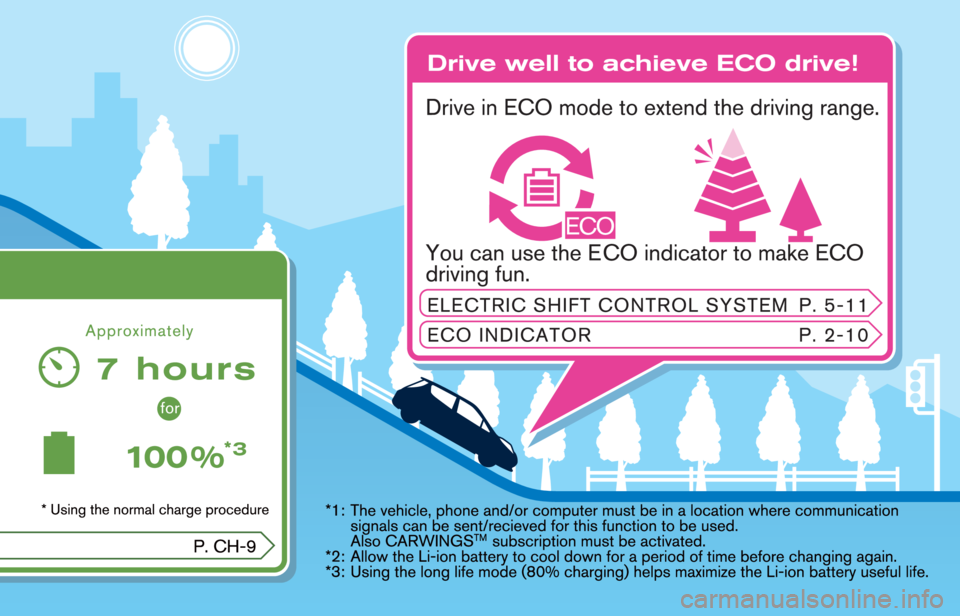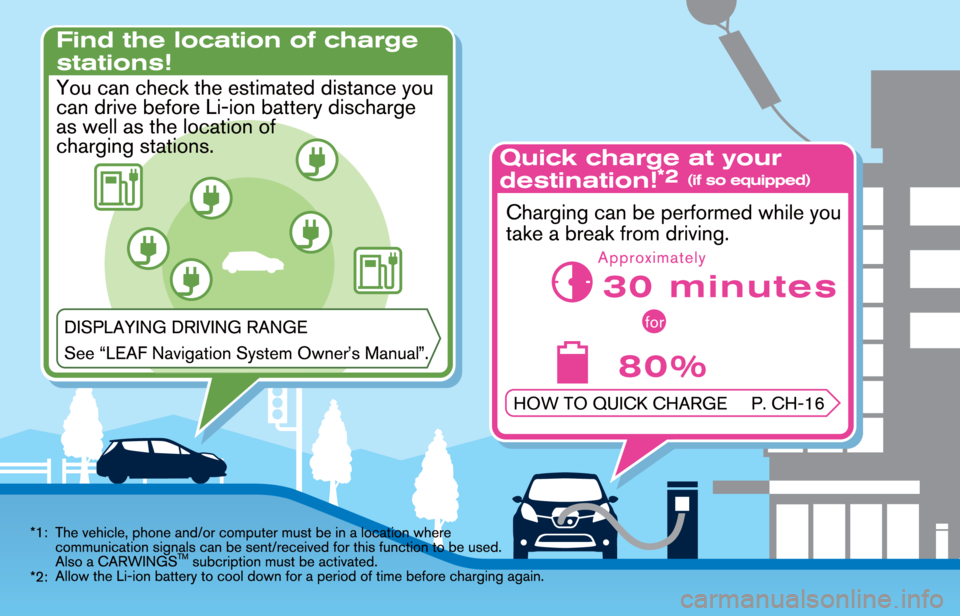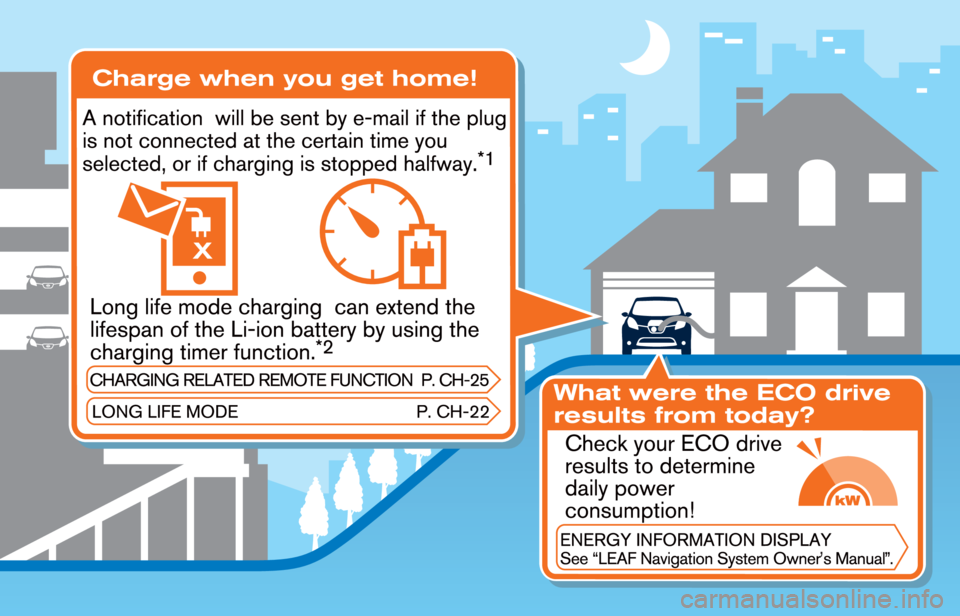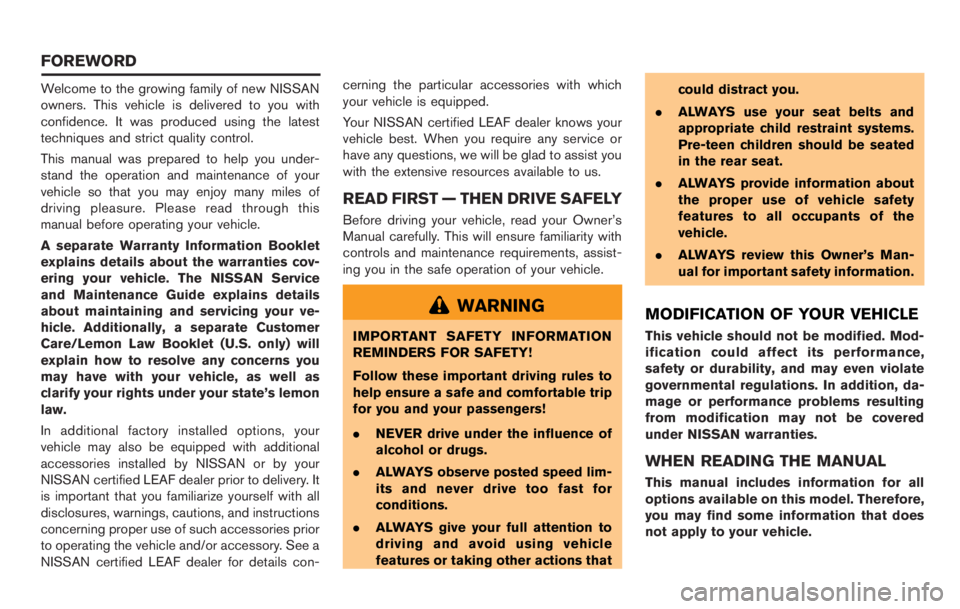NISSAN LEAF 2012 Owners Manual
LEAF 2012
NISSAN
NISSAN
https://www.carmanualsonline.info/img/5/56728/w960_56728-0.png
NISSAN LEAF 2012 Owners Manual
Trending: keyless, odometer, tire pressure reset, trailer, dimensions, coolant capacity, start stop button
Page 1 of 1062

WARNING
.After using Emergency Tire Sealant
to repair a minor tire puncture, do
not drive the vehicle at speeds
faster than 50 MPH (80 km/h) .
. Immediately after using Emergency
Tire Sealant to repair a minor tire
puncture, take your vehicle to a
NISSAN certified LEAF dealer to
inspect, and repair or replace the
tire. The Emergency Tire Sealant
cannot permanently seal a punctu-
red tire. Continuing operation of the
vehicle without a permanent tire
repair can lead to a crash.
. Do not inject any tire liquid or
aerosol tire sealant into the tires,
as this may cause a malfunction of
the tire pressure sensors.
. If you used the Emergency Tire
Sealant to repair a minor tire punc-
ture, your NISSAN certified LEAF
dealer will also need to replace the
TPMS sensor in addition to repair-
ing or replacing the tire . .
NISSAN recommends using only
NISSAN Genuine Emergency Tire
Sealant provided with your vehicle.
Other tire sealants may damage the
valve stem seal which can cause the
tire to lose air pressure.
Page 2 of 1062
thing, immediately flush the con-
tacted area with water.
. Keep the 12-volt battery out of the
reach of children.
. The booster battery must be rated at
12 volt. Use of an improperly rated
battery can damage your vehicle.
. Whenever working on or near a 12-
volt battery, always wear suitable
eye protectors (for example, gog-
gles or industrial safety spectacles)
and remove rings, metal bands, or
any other jewelry. Do not lean over
the 12-volt battery when jump start-
ing.
. Do not attempt to jump start a
frozen battery. It could explode
and cause serious injury.
. Your vehicle has an automatic cool-
ing fan. It could come on at any
time. Keep hands and other objects
away from it.
Page 3 of 1062
Do not allow the two vehicles to touch.
2. Apply the parking brake.
If the 12-volt battery is discharged, the
power switch cannot be moved from
the OFF position. Connect the jumper
cables to the booster vehicle
*Bbefore
pushing the power switch.
3. Push the P position switch to place the vehicle in the P (Park) position.
4. Switch off all unnecessary electrical systems (headlights, heater, air conditioner, etc.).
5. Place the power switch in the OFF position.
6. Remove the vent caps on the 12-volt battery (if so equipped) . Cover the battery with a
firmly wrung out moist cloth to reduce the
hazard of an explosion.
7. Connect jumper cables in the sequence as illustrated (
*1?*2?*3?*4).
Page 4 of 1062
Page 5 of 1062
Page 6 of 1062
TOWING RECOMMENDED BY
NISSAN
NISSAN recommends that your vehicle be
towed with the driving (front) wheels off the
ground or that the vehicle be placed on a flatbed
truck as illustrated.
Page 7 of 1062
Page 8 of 1062
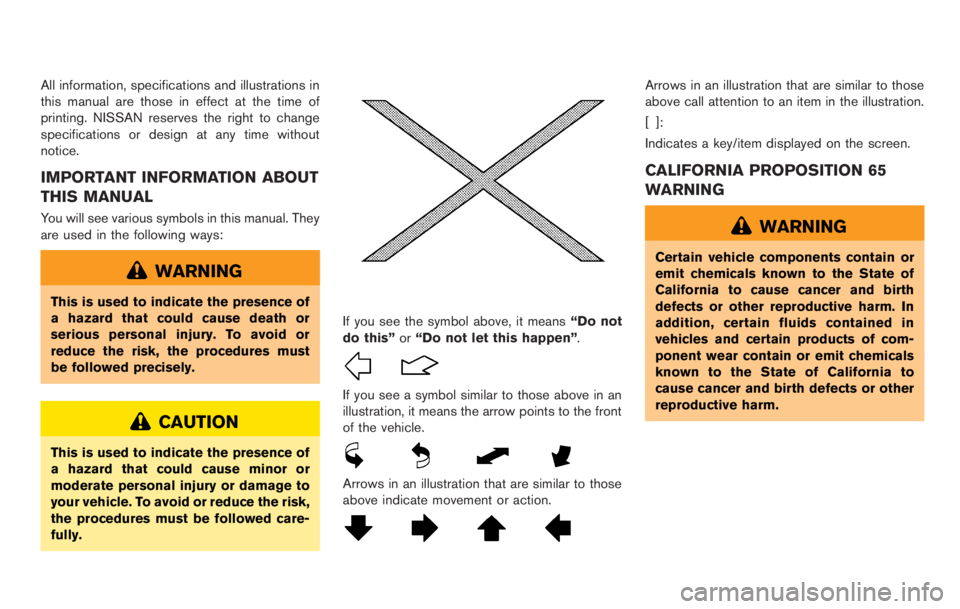
.Never tow a vehicle using the vehi-
cle tie down hook or recovery hook.
. Always pull the cable straight out
from the front of the vehicle. Never
pull on the vehicle at an angle.
. Pulling devices should be routed so
they do not touch any part of the
suspension, steering, brake or cool-
ing systems.
. Pulling devices such as ropes or
canvas straps are not recommended
for use in vehicle towing or recov-
ery.
Rocking a stuck vehicle
If the vehicle is stuck in sand, snow, mud, etc.,
try to free it by following the procedure below.
1. Turn off the Vehicle Dynamic Control (VDC)
system.
2. Make sure the area in front and behind the vehicle is clear of obstructions.
3. Turn the steering wheel left and right to clear an area around the front tires.
4. Slowly rock the vehicle forward and back- ward.
.Shift back and forth between the R
(Reverse) and D (Drive) positions.
.Apply the accelerator as little as possible
to maintain the rocking motion.
.Release the accelerator pedal before
shifting between R and D.
.Do not spin the tires above 35 MPH (55
km/h).
5. If the vehicle cannot be freed after a few tries, contact a professional towing service
to remove the vehicle.
Page 9 of 1062

If the electric parking brake cannot be released
by operating the electric parking brake switch,
the parking brake can be mechanically released.
Note that the following procedure must be
performed only when the parking brake needs
to be released in an emergency.
NOTE:
.Depending on the type of parking
brake system malfunction, the parking
brake switch operation indicator may
blink and the electric shift control
system warning light may illuminate in
the meter.
. If the electric shift control system
warning light illuminates in the meter,
stop the vehicle in a safe location and
contact a NISSAN certified LEAF dealer
immediately.
. The mechanical release of the parking
brake should only be done if there is a
malfunction of the electric parking
brake system. After the parking brake
mechanical release has been done, the
vehicle needs to be repaired. Have your
vehicle inspected by a NISSAN certified
LEAF dealer.
To release the parking brake mechanically,
perform the following procedure. 1. Confirm that the vehicle is in the P (Park)
position. If the vehicle cannot be placed in
the P (Park) position, contact a NISSAN
certified LEAF dealer.
2. Check that the parking brake switch opera- tion indicator does not illuminate.
3. Place power switch in the OFF position.
4. Open the rear hatch.
5. Remove the tool for mechanical release from the tool set that is located in the cargo area.
6. Remove the luggage floor board from the cargo area.
7. Remove the cap by turning counterclock- wise.
8. Insert the tool and turn it counterclockwise while pushing it in.
9. Continue to turn it until it stops and then release your hand. The tool will then return
approximately the same position it was in
before it was turned and release of the
parking brake will be completed. Do not turn
the tool beyond the point at which it stops.
Doing so may result in damage.
10. Store the tool for mechanical release by performing the procedure for removing it in
reverse.
Page 10 of 1062
.If the vehicle is driven with the
electric parking brake applied, the
electric brake components may
overheat causing a deterioration in
electric parking brake effectiveness
and premature electric parking
brake wear.
. The electric parking brake mechan-
ical release tool should be used
only to release the electric parking
brake in an emergency.
NOTE:
The electric parking brake mechanical
release tool can only be used to release
the electric parking brake. It can not to be
used to apply the electric parking brake.
The electric parking brake operation
switch indicator may turn off 1 minute
after the power switch is placed in the OFF
position. If the parking brake switch op-
eration indicator does not turn off, contact
a NISSAN certified LEAF dealer.
Trending: charging, load capacity, horn, heater, headlight aiming, motor, immobilizer



